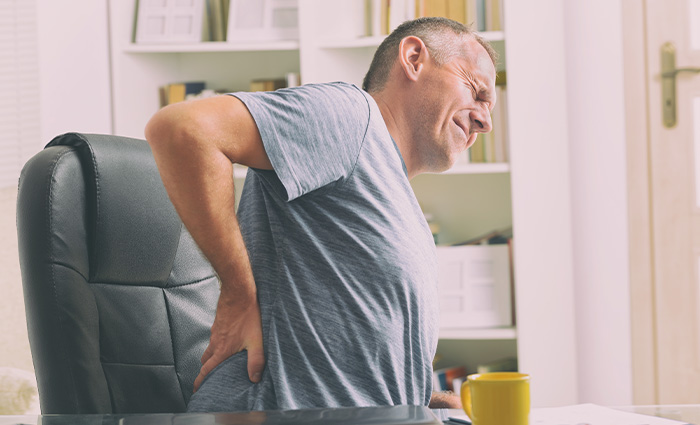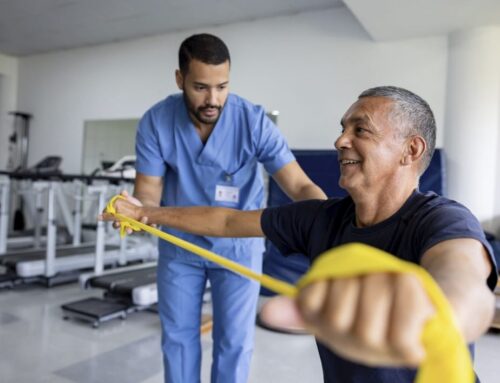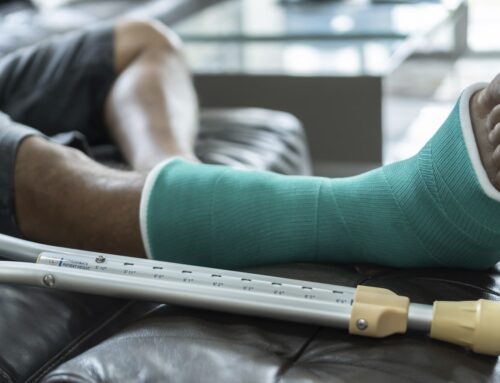As a major support structure for your body, your back needs to be in good condition for you to complete most everyday tasks. When you throw your back out, you can suddenly and unexpectedly experience acute pain and find your mobility severely limited.
As we age, the cumulative wear and tear on our backs can leave us more susceptible to injury. Preventing and quickly treating back injuries is critical to keep your body healthy and moving well into your advanced years. It is important to discuss any serious back pain or unexpected symptoms with an orthopaedic spine specialist to avoid exacerbating an injury or causing permanent damage.
How do you throw your back out?
Throwing out your back generally means you have temporarily pulled or sprained a muscle in your back, often in the lumbar region. There are numerous ways in which you can throw your back out, including:
- Twisting your back
- Lifting heavy objects
- Over-extension while stretching
- Poor posture
- Lack of proper back support for long periods of time
- Bodily stress or impact from sports
Muscle sprains are the primary cause of the pain of a thrown-out back. Discomfort can also occur when other structural parts of the back are damaged, such as blood vessels, ligaments and tendons.
What does it feel like when you throw your back out?
When the strained muscle in your back causes a spasm, you will often feel acute pain immediately following the injury. Pain intensity can range from minor to severe and is usually localized around the lumbar area. Many who suffer a thrown-out back lose range of motion and develop a hunched posture. Consistent pain, stiffness and muscle spasms are common symptoms.
With swift treatment at home, thrown-out backs may heal on their own within several days or up to two weeks. However, if you develop certain symptoms, immediate medical attention is often necessary to properly treat the injury.
How do you treat a back sprain at home?
The most important thing to do immediately following a back injury is rest. Resting will allow your body to heal, reduce inflammation and enhance the effectiveness of other remedies. Depending on the severity of the sprain, you may need to rest several days before integrating certain everyday activities back into your routine.
Lie down flat on your stomach on a hard surface with your hands to your side. Relax your body to allow your tight back muscles to soften and release pressure around the nerves. Apply covered ice packs to the affected area in 10- to 15-minute intervals to reduce swelling and radiating pain.
Additional treatment options to consider:
- Over-the-counter anti-inflammatories such as Aleve and ibuprofen reduce swelling and provide pain relief.
- Sleeping on your back provides support and reduces the risk of agitating the sprain.
- Spine-specific physical therapy can help reduce pain and strengthen muscles that support the spine
- Massage may help ease acute low back pain, reduce stiffness and stimulate blood flow.
Although initial rest is critical to the healing process when you throw your back out, staying active when the pain subsides and gradually resuming movement is equally important. Light, continuous movement and slow stretching enhance blood flow, restore motion and prevent stiffness. Avoid movements that could normally result in a back injury, like twisting or lifting heavy objects.
When should I see a doctor about my back pain?
A thrown-out back is most often due to a temporary muscle sprain, but more serious conditions can result in similar pain. Serious injuries can include herniated disks or muscular tears that may require medical intervention for a full recovery. A thrown-out back can also indicate other concerning medical issues, such as arthritis, kidney stones, osteoporosis and even certain forms of cancer.
If you experience any of the following symptoms, seek immediate medical care:
- Pain or numbness in the legs
- Bowel or bladder control problems
- Fever, chills or other signs of illness
- Intense, enduring pain that limits your ability to perform simple tasks
- Persistent pain that lasts for longer than a week
Your orthopaedic spine specialist will ask you about symptoms and possibly take X-rays, a CT scan or MRI to assess the extent of the injury and recommend treatment options for back pain.
How can you prevent back sprains?
Staying active is essential to avoiding back injuries. Engage in regular aerobic activities and stretching exercises to build strength, endurance and flexibility. Staying active also helps you decrease excess weight, which is a major risk factor for back injuries. Pay attention to proper posture both standing and sitting. Move safety by employing proper mechanics when lifting objects and performing sudden movements.
Seeking treatment when you throw your back out
Back injuries can be seriously crippling in the moment, but they do not have to be worrisome if you take the right steps to resolve them. If you throw out your back, be patient the recovery process and don’t hesitate to reach out for medical attention. Contact the orthopaedic spine specialists at Cary Orthopaedics for a appointment in Cary, Holly Springs or Morrisville.






